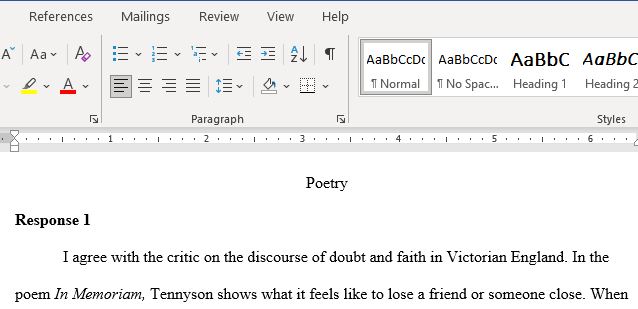Discuss The Ways in Which This Week’s Readings Contributed to What One Critic Calls the Discourse of Faith and Doubt in Victorian England
Question: We are reading works from five poets—a sampling rather than a definitive statement but there should still be plenty of material to explore.
In a different section of “In Memoriam”, Tennyson writes:
“There lives more faith in honest doubt, /Believe me, than in half the creeds”.
Discuss the ways in which this week’s readings contributed to what one critic calls “the discourse of faith and doubt” in Victorian England.
My Response:
The discourse of faith and doubt has been highlighted in ‘Sonnet 14’. Browning asserts that eternity love is not based on the other person’s physical attributes. Such an argument introduces doubt into whether love can work if it is based on superficial reasons. The above sentiments resonate well with Browning’s ‘Sonnet 43’ which further affirms that love should be pure, free, passionate, and unconditional.
Emily Bronte’s ‘Love and Friendship’ affirms more faith in friendship than love by asserting that friendship just like a holly tree is more durable and evergreen while love just like a rose-briar is beautiful but fleeting (Bronte). In the ‘Stanzas’, Bronte purports that although life is filled with anguish, grief, and despair, the said scenarios should not warrant one to be upset because she believes that dying relieves one from adversity. Thus, Bronte asserts that there is more joy in dying as one is relieved of the problems they experience in their day to day life.
Christina Rossetti’s ‘Remember’ asserts faith in the opinion that one should not wallow in the burden of sadness and grief when they lose their loved ones but should go on with their life because death is inevitable and irreversible (Rossetti). Rossetti’s ‘When I am dead, my dearest’ further affirms her opinion that a grieving person should forget and smile rather than remember and be sad.
Sources:
Elizabeth Barrett Browning, “Sonnet 14: If thou must love me”
(from https://poets.org/poem/if-thou-must-love-me-sonnet-14) and “Sonnet 43: How do I love thee?” (from https://poets.org/poem/how-do-i-love-thee-sonnet-43);
Emily Bronte, “Stanzas” (from https://www.poetryfoundation.org/poems/47645/stanzas-56d2283e287a7) and “Love and Friendship” (from https://www.poetryfoundation.org/poems/50537/love-and-friendship);
Charles Darwin: “Evolution and Natural Selection”
(from https://globalchange.umich.edu/globalchange1/current/lectures/selection/selection.html); “Summary of Darwin’s Theory of Evolution” (from https://www.pbs.org/wgbh/evolution/educators/course/session2/explain_c_pop2.html and “What Darwin Didn’t Know” (from https://www.smithsonianmag.com/science-nature/what-darwin-didnt-know-45637001/)
Note: the readings labeled “handout” have been attached in the uploaded documents.
Task: Based on my response and using the readings provided, respond to these two, separate responses. You can say whether you agree or disagree based on my response, what you liked about their response and even add on to it.
Number One:
In Tennyson’s poem “In Memoriam”, the speaker reveals the emotions of sadness and grief at the loss of their friend. The speaker states, “O my forsaken heart, with thee” (line 9.18). The speaker is feeling a sense of abandonment and sadness because they do not know how to cope with the feeling of loss and they feel that their life force is gone and that they are in the grave beside their deceased friend. The speaker is doubting his or her faith by having a “forsaken heart” (line 9.18) and is aware that their loved one is gone. The poem reflects the influence of Darwin to some extent because the speaker’s heart is no longer with God but in doubt. Darwin’s theory of evolution caused disruption to his society because the theory of evolution challenged the theological views of the time and Tennyson is doing the same in the poem.
Number two:
I believe that in the Victorian era two ideologies were clashing: romanticism and realism. Feelings and logic, which later gave results to the Industrial Age. You can see that clash in all of the Victorian art, especially poetry. For example in Elizabeth Barrett’s “Sonnet 14”, “If thou must love me, let it be for nought Except for love’s sake only…Neither love me for Thine own dear pity’s wiping my cheeks dry”. The idealistic view of love, that marriage is not just an economical transaction or a way to ensure ‘survival of the fittest’ (according to Darwin’s theory), but it is a conjunction of souls. From a realist’s point of view this is foolish because feelings can be deceiving and it is better to be secure for the future instead of sitting on the fence. From an idealist’s point of view, this kind of transaction is heartless and cruel because you will be spending the rest of your life in a loveless marriage. “But love me for love’s sake, that evermore Thou mayst love on, through love’s eternity”.
Answer Preview For Discuss The Ways in Which This Week’s Readings Contributed to What One Critic Calls the Discourse of Faith and Doubt in Victorian England
Access the full answer containing 272 words by clicking the below purchase button

